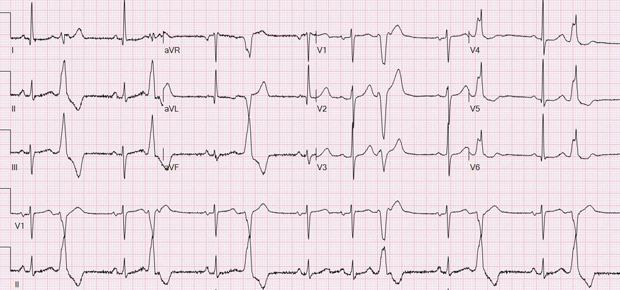MKSAP Quiz: 3-year history of palpitations, fatigue
A 42-year-old woman is evaluated for a 3-year history of palpitations and fatigue. She reports no chest pain, dizziness, near-syncope, or syncope. An exercise stress test and echocardiogram were normal when she was evaluated for palpitations 1 year ago. There is no family history of sudden cardiac death or heart failure. Her only medication is metoprolol.
On physical examination, vital signs and the remainder of the examination are unremarkable.

An electrocardiogram is shown. Ambulatory 24-hour electrocardiographic monitoring shows frequent monomorphic premature ventricular contractions (22% of all beats) and frequent ventricular bigeminy. An echocardiogram obtained 1 week ago showed mild to moderate global decreased left ventricular function with a left ventricular ejection fraction of 45%.
Which of the following is the most appropriate management?
A. Amiodarone
B. Cardiac catheterization
C. Cardiopulmonary exercise testing
D. Catheter ablation of premature ventricular contractions
Answer and critique
The correct answer is D. Catheter ablation of premature ventricular contractions. This item is Question 72 in MKSAP 18's Cardiovascular Medicine section.
Catheter ablation is the most appropriate management of this patient with frequent symptomatic premature ventricular contractions (PVCs). PVCs are common and occur in up to 75% of healthy persons. In the absence of high-risk features (syncope, a family history of premature sudden cardiac death, structural heart disease), reassurance is often appropriate management. For patients with bothersome palpitations, the initial diagnostic test is electrocardiography (ECG). If the diagnosis is not established, 24- to 48-hour ambulatory ECG monitoring is used to diagnose and quantify the frequency of PVCs and determine whether they are monomorphic or polymorphic. Symptomatic or frequent monomorphic PVCs (>10,000 PVCs in 24 hours or >10% of all beats) require further evaluation and treatment. Exercise stress testing can be used to evaluate the patient for ischemia and assess the response of PVCs to exercise. In addition, patients with frequent PVCs or polymorphic PVCs should undergo echocardiography or other cardiovascular imaging (such as cardiac magnetic resonance imaging) to evaluate for the presence of structural heart disease. Up to one third of patients with frequent PVCs can develop PVC-induced cardiomyopathy and progressive left ventricular dysfunction, as documented in this patient. First-line therapy for symptomatic or frequent PVCs includes β-blockers or calcium channel blockers. Patients with continued frequent PVCs despite medical therapy or those who develop left ventricular dysfunction should undergo catheter ablation, which resolves most cases of PVC-induced left ventricular dysfunction.
Amiodarone is usually effective in suppressing PVCs; however, it carries a high risk for adverse effects and end-organ toxicities. Therefore, amiodarone is best avoided in younger patients, such as this one.
This patient had a structurally normal heart and no evidence of ischemia on studies performed 1 year ago, and she has developed no new symptoms. Therefore, cardiac catheterization is not indicated.
Cardiopulmonary exercise testing includes assessment of respiratory gas exchange during treadmill or bicycle exercise for a more detailed assessment of functional capacity and differentiation between potential causes of exercise limitation (cardiac, pulmonary, or deconditioning causes versus volitional causes). It would not be the most appropriate next choice in a patient with a known decrease in left ventricular ejection fraction and frequent PVCs.
Key Point
- Patients with premature ventricular contraction–induced cardiomyopathy should be treated with catheter ablation.




